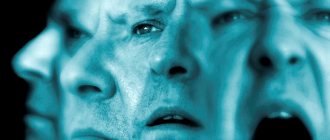Why do mental illnesses worsen in spring?
Psychiatric deviations are often insidious in nature; they can subside for a long time, and a person will feel healthy, but with the slightest change in external conditions, they will return and manifest themselves with renewed vigor.
This is why mental illnesses worsen in the spring: this occurs due to a sharp restructuring of natural factors that have a powerful effect on the human body: nervous activity, hormonal levels, blood supply and metabolism.
The prognosis for the recovery of people with mental disorders is very conditional; treatment is complex and complex, with the use of medications and psychotherapy.
As a result of treatment, some types of mental disorders are cured permanently, while others struggle with them for life.
What to do if your loved one is mentally ill?
You need to prepare for the fact that your life can change greatly and learn how to behave correctly. A mentally ill person often becomes the center of attention for the entire family. Personal interests of household members fade into the background. We have to put up with the patient’s inappropriate behavior. You also need to prepare for the fact that the treatment may not work immediately. Sometimes the drugs prescribed initially do not help, and new ones have to be selected.
Yes, if a person has a mental illness, his relatives have a hard time. Some tips will help you withstand these stresses and maintain your own health:
- Control your emotions. Don't take what the patient says and does personally. Remember: he has no control over himself.
- Take breaks and find time to rest. You need to take turns sitting with the patient. If you don't have relatives who can help, hire a caregiver and have them come at least sometimes.
- If you feel emotionally damaged, see a psychologist or therapist. Don't wait for the problem to get worse.
- You must eat well and get enough sleep. Otherwise, you will not be able to cope with the load.
If you notice the symptoms described in this article in a loved one and think that they may be mentally ill, contact the specialists at the Cordia Clinic for help. Our experienced doctors will definitely try to help.
Mental illnesses: list and description
Psychologists and psychiatrists identify the following groups and types of mental illnesses :
- Phobias (panic and stress states) are disorders that arise against the background of an exaggerated sense of fear. In these cases, the natural defensive reaction to danger becomes the dominant human response to any external stimuli.
- Depression . They manifest themselves as a loss of interest in life and a negative perception of it.
- Neuroses (hysteria, neurasthenia, obsessive states) occur with increased irritability and excitability of patients, imaginary somatic complaints, violent emotional reactions to life's difficulties and troubles.
- Mental retardation (in children) and mental retardation in all age groups. Such pathologies are characterized by a moderate or severe lag from normal indicators of thinking, perception, speech, behavioral or communication skills.
- Paranoid pathologies and schizophrenia are diseases that have specific symptoms. The hallmarks of paranoia include confusion and delusional thoughts. Schizophrenics try to isolate themselves from society; they are focused on themselves or some “super important” idea.
- Epilepsy is a disease that causes seizures and loss of consciousness.
- Affective pathologies . They manifest themselves as behavioral disturbances in response to ordinary external stimuli (reactions of anger, tearfulness, aggression).
- Psychoses . These conditions are associated with the development of mania (obsessive thoughts about persecution, sabotage, eavesdropping) or a combination of mania and a depressed state of mind (depressive thoughts about suicide, the presence of an incurable disease, the meaninglessness of existence).
What symptoms should you look out for?
One page on our website is not enough to describe all the symptoms of mental illness. You can learn more about them by reading other articles on our blog or in the section that lists the diseases treated by doctors at the Cordia Clinic. Here we list the main ones, those that you need to pay attention to first:
- Social isolation . A person ceases to be interested in those around him, he stops communicating and participating in common affairs.
- Decreased performance . Mentally ill people no longer cope normally with household chores and work. Children's performance at school sharply declines, and complaints from teachers are received more often.
- Thinking disorder . Problems arise with memory, concentration, and logic. A person does not understand the obvious, it is difficult for him to explain something to others, he cannot find the right words. In severe cases, speech turns into a meaningless set of words.
- Increased sensitivity to irritants . Patients can feel sounds, light, taste, touch more acutely, they avoid irritants that cause them discomfort.
- Apathy . You lose interest in anything at all, even in activities that previously brought you pleasure.
- Brad . A person talks about something that does not exist in reality. He greatly exaggerates or downplays his capabilities, believes that someone is watching him, pursuing him, trying to cause harm.
- Emotional problems . Frequent companions of mental illness are increased irritability, isolation, depression, anger, violent causeless joy and optimism, suspicion, and a feeling of internal tension.
- Unusual behavior . The person is clearly behaving inappropriately.
- Frequent and severe mood swings.
- Appetite and sleep disorders . Some patients become gluttonous, while others, on the contrary, do not eat anything. May cause insomnia or excessive sleepiness.
- Destructive thoughts and behavior . Very alarming bells are thoughts of suicide, the desire to harm yourself and others.
- Hallucinations . A person sees, hears and feels something that is not really there.
Patients often refuse to acknowledge the severity of their condition. They believe that everything is fine with them, but something “wrong” is happening to others. Any attempts to convince them of anything, reproaches and complaints lead nowhere and can only provoke a negative response. This symptom in psychiatry is called lack of criticism, and it clearly indicates a mental disorder.
Causes of mental disorders
The factors that cause mental illness are theoretical; the practical relationship with mental disorders has not yet been proven.
In medical science, there are 2 groups of possible causes that determine the appearance or progression of mental disorders:
- External : - exposure to toxins of biological (waste products of bacteria and viruses) or chemical (poisons and toxic substances) nature; — radioactive radiation; — traumatic brain injuries; - excesses in upbringing or lack of attention in childhood, emotional trauma (stress and anxiety) at any age; - abuse of psychoactive substances (alcohol and (or) drugs; - long-term physical illnesses; - professional activities that require constant concentration and concentration; - oxygen starvation of brain tissue.
- Internal : - genetic predisposition, heredity; - disturbance of the mechanisms of balance between the processes of tension and relaxation in the nervous system. - organic brain damage associated with acute or chronic inflammatory changes in it; - diseases of large and small vessels supplying blood to the brain structures.
The most common cause of mental disorders is organic damage to the brain or its blood vessels (strokes, tumors, injuries). At the same time, disturbances in the sphere of perception, thinking and speech can be temporary and disappear after treatment or accompany patients throughout their lives.
In cases of drug addiction and alcoholism , mental disorders progress steadily.
Preserving people's mental health is only possible if they completely abandon these addictions.
With the development of schizophrenic disorders, manifested in a sharp change in habitual life values and hobbies, paranoia with the development of delusional ideas, constant monitoring and treatment by a psychiatrist .
When to seek professional help
Perhaps you or your loved ones have developed suspicious signs of one or another type of psychological disorder. This may include insomnia, fear, depression, short-term memory loss, loss of spatial orientation, and even hallucinations. In such cases, it is recommended to immediately contact a specialist!
Modern medicine has long used special diagnostic tests that make it possible to determine a real mental disorder in the early stages. So often the problem of simple emotional exhaustion and fatigue can be mistaken for a full-fledged mental disorder and vice versa. Therefore, you should never self-diagnose and try to recover by taking antidepressants or sedatives.
The Korsakov clinic uses a modern recovery method, approved not only by the Russian healthcare system, but also by a number of Western experts. The complex of mental health treatment measures also includes establishing a lifestyle, reducing stressful situations, establishing a healthy diet, fortifying the body, and protecting oneself from social and everyday problems. In the process of in-depth psychological assistance, a person’s social activity is restored and negative factors are neutralized. As a result of such actions, the nervous system usually returns to normal.
We also recommend reading the article about gambling addiction.
Signs of a mental disorder
Each mental disease has its own clinical picture.
You can suspect the presence of such disorders by observing the following symptoms and signs:
- a person persistently gives out wishful thinking;
- expresses incoherent (delusional) thoughts;
- strives for loneliness and isolation, tries to isolate himself from any communication with others;
- reacts sharply to troubles and criticism (throws hysterics, shows verbal and physical aggression);
- cannot concentrate attention on important things, conversation, household or professional activities for a long time;
- lives in the past and constantly remembers difficult life experiences, is immersed in a world of illusions, with a reduced reaction to objective circumstances and external stimuli;
- memory deteriorates, gaps appear in it;
- the patient constantly performs some obsessive actions and rituals (frequently washes his hands, arranges household items only in a certain order, leaves the house only under a combination of circumstances that suit him).
Where does male schizophrenia begin?
In almost 100% of cases, the disease reveals itself as a person’s detachment from society. The representative of the stronger sex becomes withdrawn and unsociable. From the outside he looks depressed and depressed. Shortly before the blossoming of the process, the patient is overcome by a pessimistic mood. Remarks like: something is wrong, but I don’t understand what exactly. What is happening to me?
A sad symptom of schizophrenia is coldness towards loved ones. The patient withdraws from the family, believing that relatives are capable of causing harm. Sensitivity and the ability to empathize are lost. The head of the family becomes indifferent to everything that used to be the center of life. Work is uninteresting, household responsibilities are no longer of concern. Hobbies are abandoned.
A person is overcome by a wave of fatigue and apathy. I don't want to do anything. There are no aspirations or goals.
The problem is that the stronger sex is by nature more reserved and emotionally poor. Such signs, if they also develop gradually, rarely suggest a disorder. Rather, they are mistaken for an age crisis and associated with failures at work. Usually in such a situation, relatives begin to get angry with the sufferer for his passivity, or take offense at indifference and coldness. Others are at a loss, not understanding what is happening.
Schizophrenia can also manifest itself with outbursts of aggression and rapid mood swings. Patients become extremely suspicious and see conspiracy everywhere.
A sure sign of a schizophrenic debut is a feeling of threat, loss of self-confidence. Inability to correctly assess reality.
The girl describes her lover. The man is 40 years old. He occupies a high position in society and earns good money. Became unsociable. Withdraws into himself. There is eternal melancholy in the eyes, you can’t wait for a smile. Suddenly there are outbreaks of aggression. He might shout and throw him out the door. Here’s a case: we had dinner together in his apartment. Suddenly he stood up, went to another table, and began to look around suspiciously. He said that the chairs and table had been moved, everything was out of place. He began to rearrange the furniture. Then he also suddenly stopped his vigorous activity, returned to the table, and continued his meal.
Insomnia systematically accompanies schizophrenic people. The condition arises from the patient's constant need to be alert. Distrust of others, the expectation of a catch makes you remain in tension. The person has difficulty falling asleep, the whole body twitches as if in convulsions. In the middle of the night he wanders around the room, sleep does not come.
By the way, the idea that colored dreams are a sign of schizophrenic disorder has been misinterpreted. Colorful dreams are evidence that a person feels the world around him too subtly. Subtlety of perception is a sign of increased vulnerability. Vulnerability is one of the signs of schizophrenia. This leads to the conclusion: schizophrenics see colorful dreams several times more often than ordinary people.
The appearance of the patients shows sloppiness. They stop taking care of themselves, don’t wash, their clothes are dirty, and there is multi-day stubble on their faces.
The manifestation of volitional efforts becomes especially difficult for the stronger sex. It is difficult to make decisions and take responsibility. Having taken up a task, they abandon it halfway and do not complete it. Previously proactive, the person now loses organizational skills. Independence goes away, what remains is powerlessness, confusion, and complete inactivity.
The person becomes unbearable and difficult to understand. Sudden aggressiveness, giving way to coldness and indifference, strange behavior frightens relatives. At first, loved ones are lost, not understanding what happened. Then they try to correct the situation, to help the patient return to his original state, but his reaction to such efforts is absent. There is no gratitude from him, as well as attempts to correct the situation. He lives in his own world, commits actions that defy logic.
Especially for male schizophrenia, aggressive behavior is characteristic. Patients often engage in assault and throw themselves at people. As a result, the patience of relatives comes to an end, and the person loses his family.
In men, the initial symptoms of schizophrenia manifest themselves more violently and quickly take over the suffering personality. Because of this, a significant portion of patients quickly lose their jobs and property. Changes in behavior frighten them. The world around us becomes hostile. The area is familiar, the faces seem foreign. The new environment, on the contrary, creates a feeling of comfort. To cope with extreme stress, even shock, men often resort to drinking.
Diagnostics
Only a specialist can establish a mental disorder; for this, he comprehensively studies the patients’ complaints and lifestyle, and conducts an examination using clinical methods.
The use of special questionnaires allows us to identify anxiety disorders, predisposition to depression, affective disorders, and aggression.
Many psychological techniques used in psychiatry have been adapted for use by ordinary people and are posted on the Internet.
Nowadays, anyone can take a mental illness test online and get an interpretation. The network contains the characterological questionnaire of K. Leonhard, the Sheehan anxiety scale, and the Rorschach blot technique.
However, when conducting such tests, people must understand that the information from them is of an introductory and tentative nature; only a doctor can give an accurate interpretation of the test studies.
In addition, instrumental methods may be required to diagnose the causes of mental disorders:
- electroencephalogram;
- X-ray or MRI of the head;
- substance use tests;
- blood chemistry.
BAR
Bipolar affective disorder (BID) is a disorder in which manic (emotional, energetic, cheerful, but often irritable) and depressive episodes alternate. BAR has two forms. Type I includes one or more episodes of mania or major depression. In type II bipolar disorder, there are short episodes of hypomania (a milder form of mania), but depressive phases predominate. There is also cyclothymia - multiple cyclical mood swings in the form of hypomania and mild depression for at least two years of life.
What therapy is used? Medicines are the main, but not the only effective treatment for bipolar disorder: in the case of taking medications alone (these are mood stabilizers, antidepressants, and sometimes antipsychotics and tranquilizers), the relapse rate in the next two years is approximately 60%.
Some patients with bipolar disorder may have problems with adherence to medications and/or the effects of the disorder. This is where psychotherapy can make a difference. According to the American Psychological Association, the psychotherapy of choice for the treatment of bipolar disorder may include psychoeducation, CBT, interpersonal and social rhythm therapy, and family-focused therapy.
How does it help? Psychotherapy allows us to understand the mechanisms of the disease and the consequences of its impact on social life. Mood is stabilized, hospitalizations are reduced, and the patient gains cognitive and behavioral skills to manage symptoms. Thanks to this, the quality of life and relationships with other people improve.
How long does it last? A difficult question: bipolar disorder often occurs in parallel with other disorders, such as addictions, and this affects the duration of therapy. Most likely, with bipolar disorder, psychotherapy will be supportive in nature, that is, it will be long-term. Psychoeducation and normalization can take 10–15 sessions.
Symptoms of mental disorder in men
In the male population, the most common mental disorders are:
- schizophrenia;
- persecution mania;
- sexual disorders (decreased potency, premature ejaculation, desire for perversion).
Mental disorders in men are characterized by:
- deterioration of general well-being and decreased emotional background;
- the occurrence of unreasonable reactions of anger, aggression and irritability;
- desire to limit contacts with people, avoidance of female society, immersion in professional activities.
Mental disorders are more common in men than in women.
This is due to the spread of harmful addictions among them (alcoholism and drug addiction), hormonal characteristics (increased levels of testosterone and norepinephrine), work related to dangerous and responsible professions (managing land, air or sea modes of transport, being in political, police and army posts).
Why do men get sick more often?
Statistics have given a verdict: the stronger sex suffers from schizophrenic disorder more often than the weaker. The fact of primacy is associated with various factors: high hopes are placed on the stronger sex, more claims are made against it, and many expectations are associated with it.
A man in the eyes of society is a protector, a provider, a support. If the stronger sex is the head of the family, the responsibility for providing for the family falls on his shoulders. The modern world poses the financial question quite harshly. To earn money, a representative of the strong half of humanity has to work hard. Physical and mental stress is classified as chronic stress, which is an important factor in provoking the disease.
Fun fact: bachelors are 4 times more likely to suffer from the disorder than married people.
Another reason for the prevalence of the disease among the male population of the planet is considered to be physical injuries, in particular to the head. Its representatives are fond of traumatic sports: boxing, karate. Women drive cars more intensively, becoming involved in accidents. They serve in the army and take part in hostilities. Banal yard fights are more common among boys. All this becomes an excellent breeding ground for brain damage. And then - depending on your luck.
Among men, alcohol abuse is more common; drugs poison the brain, causing severe intoxication.
Patients are able to put forward their theories and ways to resolve the disease.
A schizophrenic man claims: one of the provoking factors of the disease is pride. From childhood, the guy was proud, and also a braggart. He did not recognize God, and when he began to come to the atheist in visions and call him to himself, he fell into magic. He imagined himself to be the messiah, the savior of humanity. After treatment there was relief. I started going to church and reading the Bible.
An interesting theory about genius personalities. In literature you can often find the statement of the legendary psychiatrist Cesare Lombroso: genius and madness go hand in hand. Or the words of the great Aristotle that genius inevitably presupposes madness. And indeed: among the male population there are much more hidden geniuses than among the female population, which explains the higher frequency of male schizophrenia.
Symptoms in women
Women most often suffer from pathologies in the affective sphere, depression, eating disorders (bulimia, anorexia) and nighttime sleep disorders (insomnia), increased anxiety and persistent phobias.
Signs of mental disorder in women:
- loss of interest in one’s appearance (lack of care), family, children, work, the opposite sex;
- tearfulness, irritability, suspiciousness;
- neglect of food or constant overeating, fear of nightfall, fear of leaving the house, etc.;
- memory loss, absent-mindedness, self-absorption;
- various complaints about physical health (headaches, gastrointestinal disorders, heart failure).
Age limits
Mental disorder in the stronger sex starts much earlier than in the female. The first signs of schizophrenia in men can be traced back to childhood, at the age of 2-4 years. The behavior is noteworthy: motor activity, which is usually increased at this age, decreases. Boys neglect the company of their peers. They are looking for solitude.
The mood is usually labile. Kids are capricious and whine for no reason. Boys with developing schizophrenia are not inclined to show strong emotions and withdraw into themselves. During a conflict situation, they are unable to respond to an insult.
Such children are characterized by groundless fears. The emotions shown are often inappropriate. Acquired skills are lost.
Given the nonspecificity of symptoms, it is difficult to suspect a schizophrenic disorder. The child is accused of self-indulgence and blamed on age. Meanwhile, the disease continues to develop.
The manifestation of the disease in adolescence, up to 16 years, becomes common among males. Social isolation is typical when a teenager stops communicating with friends, avoids mass gatherings, and becomes indifferent to loved ones.
Guys are interested in mysticism: magic, esotericism, extrasensory perception. A sudden fascination with religion is a pretty telling sign.
Young men stop taking care of themselves, brushing their teeth and washing. Oddities appear in facial expressions and movements: twitching, harshness.
In teenage boys, symptoms are attributed to hormonal changes. Features: unsociability, inactivity, emotional instability.
It is believed that the favorable age for the development of male schizophrenia is 16-35 years, but the peak incidence occurs at 30 years. For comparison: for women, the onset of the disease is typical at 28-37 years of age.
General signs of schizophrenia in men, different from women:
- severe course, deep destruction of personality;
- characterized by a chronic course. Women are more prone to a sluggish and paroxysmal form;
- higher incidence due to increased brain vulnerability;
- brightness, severity of pathological changes, quickly leading to loss of ability to work.
Mental illnesses in children
The most common mental illnesses in children are developmental delay (developmental delay), autism and hyperactivity.
1. Delayed development of a child can manifest itself in a small vocabulary for his age, the inability to master certain actions and games that peers operate in full.
2. Autism (a childhood form of schizophrenic disorder) is characterized by the child’s voluntary withdrawal from communication with adults and children, isolation, hypertrophied development of any one ability of the child (counting, drawing, singing) or a progressive decline in intelligence.
3. Hyperactivity in children consists of the inability to concentrate attention, maintain motor calm, perceive learning in full and control their behavior.
What's next
Gradually, the sick male brain begins to draw its own picture of the world, to interpret what is happening in its own way.
The sufferer creates a new reality based on new sensations. Everything seems unreal to him; the feeling of altered consciousness, as if hypnotized, does not leave him. There is a hidden meaning, encrypted messages in everything. Walking down the street, a person witnesses a fight, and he becomes convinced that this performance was staged especially for him and carries hidden information. As the pathological process develops, the gradation of symptoms into positive and negative becomes more noticeable.
Negative symptoms of male schizophrenia include:
- isolation;
- avoidance of communication;
- emotionlessness;
- lack of will;
- apathy;
- neglect of personal hygiene.
Human behavior is changing more and more. Autistic traits are on the rise. A characteristic sign is loss of eye-to-eye contact.
Behavior is characterized by ambivalence, that is, duality: I want - I don’t want, I do - I don’t. A typical example. A schizophrenic comes to see a doctor. He extends his hand to say hello and abruptly pulls him away. Then he stretches it out again, withdraws it again, as if hesitating.
Problems in the cognitive sphere are growing sharply. Representatives of the stronger sex become absent-minded. Lost concentration. Perception and memory are impaired. Thinking is disorganized and illogical. As a result, the speech turns out to be difficult to understand, full of new words invented by the patient. Inferences are drawn incorrectly. A schizophrenic person thinks according to his own schemes, incomprehensible to others, which is why he seems absurd and insane to others.
It is worth noting that the basis of pathological thinking is not so much a violation of intelligence as a different perception of reality. A different picture of reality in the inner world of the male self, caused by changes in the psyche.
A number of psychiatrists believe: the later the disorder debuts, the more intact the intellect remains. Such individuals turn into real geniuses of science and art. They make incredible discoveries and become engines of progress. Scientists believe: such schizophrenics are simply a treasure for society and provide invaluable benefits. The mental abilities of schizophrenic geniuses are much higher than those of healthy non-geniuses.
There is a complete modification of one's own self. Sometimes people with schizophrenia themselves talk about themselves in the third person. The male personality is split into two. It’s as if two opposite people coexist in it: one does, the other criticizes. Gradually, there is a complete disintegration of the personality, in which it is already difficult to see the former one.
Unusual sensations in the body constantly accompany the patient. Complaints of headaches similar to migraines or brain tumors are typical. Headaches have a non-standard interpretation.
A man with schizophrenia claimed that his brain was increasing in size, swelling, filling all the space in the skull, pressing on the bones. The pressure is so great that your head is about to explode. The brain is so swollen that it hangs over the eyes, presses on the brow ridges, the eyelids - they protrude outward, the eyes will soon fly out of their sockets.
This syndrome even received a separate name: brain swelling.
Color perception also changes in schizophrenic disorder. Men are more likely to have a weakened reaction to color factors. Preference is given to a calm, muted palette, in contrast to women who prefer bright colors.
The color choice often depends on the form of the disease and the prevailing symptoms. For example, with the paranoid form, men gravitate toward blue and yellow colors. For depression, gray tones are chosen. The colors red and black have a stimulating effect on schizophrenics.
Treatment of disorders
Therapy for mental disorders involves a number of activities:
- psychotherapy (individual and group classes), auto-training, neurolinguistic programming;
- course of medication, depending on the cause of the disease: sedatives (Valerian, Motherwort, Afobazole, Tenoten), tranquilizers (Hydroxyzine, Buspirone and analogues); neuroleptics (Propazina, Flupenthixol), antidepressants (Befola), nootropics (Mexidol, Pantogama), mood stabilizers (Valpromide, lithium salts);
- acupuncture, massage, narzan baths;
- giving up bad habits, avoiding stress, leading a healthy lifestyle.
Reactions to stress: PTSD
Stress is a universal physiological reaction to the influence of various unfavorable factors, physical or psychological. The goal of therapy in this case is to help the person adapt to changes.
Reactions to stress can be different, and they do not always require the intervention of specialists. Some of them go away on their own after a certain time. But some, such as post-traumatic stress disorder (PTSD) and complicated grief, can last for years and significantly impair a person's quality of life. In such cases, it is necessary to contact a psychotherapist or psychologist.
Traumatic events are situations that pose a direct or indirect threat to the life and health of the person himself or his loved ones (including sexual violence). In cases of prolonged or extreme traumatic events, such as torture, child sexual abuse, severe domestic violence, etc., complex PTSD may develop.
PTSD may be partial (subclinical), meaning it may not meet all the criteria for a diagnosis. But if there is a decrease in quality of life due to presenting symptoms, then intervention is also required.
How to recognize PTSD?
Signs of the disorder: worries about the traumatic event in involuntary thoughts and memories, nightmares, flashbacks; avoidance of thoughts, actions and situations associated with the traumatic event; increased alertness and overexcitation, insomnia.
What therapy is used? Recommended therapy for PTSD, according to American Psychological Association and NICE practice guidelines:
- Trauma-Focused Cognitive Behavioral Therapy (TF-CBT): Prolonged Exposure Therapy; cognitive therapy; cognitive processing therapy.
- Eye movement desensitization and reprocessing.
- Short-term integrative therapy.
- Narrative exposure therapy.
How does it help? As a result of therapy, a person learns to process his trauma: the event will remain in the past and will no longer affect the quality of life. To understand this process, you can imagine that we have a large closet full of crumpled things, where everything is mixed up. The only way to get organized is to open the closet and go through all the things; the same thing happens with traumatic experiences in the process of work. There is evidence that the average patient treated with prolonged exposure therapy does better than 86% of the control group; Other “focused” methods give similar results.
How long does it last? On average, all interventions take from 8 to 16 sessions (session duration is from 45 to 90 minutes), but sometimes more may be required.
Alcohol and drug addiction
Alcohol and drugs are powerful antidepressants and tranquilizers. Initially, these addictions are not so much a disease as ways to relieve stress, lift your spirits and fill an inner emptiness. But the underlying reason may lie elsewhere.
Photo: istockphoto.com
It is worth distinguishing between “domestic drunkenness” and “alcoholism”. The first is called the method of relaxation and stress relief. There's nothing critical about having a glass of wine with dinner or a glass of beer on a Friday night. In this case, only mental dependence on alcohol can form.
But alcoholism is an obsessive desire to turn off consciousness, when a person wants to get drunk and forget. At the same time, both physical and mental dependencies are formed: alcohol becomes an indispensable substance in the biochemical reactions of the body.
Emotional instability
Most often it manifests itself through explosive emotions that cannot be controlled. And if in public places people can still restrain themselves, then among family and friends this control is almost completely lost. And then minor mistakes, for example, unfinished lessons or scattered things, lead to uncontrolled aggression.
It's all in your head: why it's important to take care of your mental health








